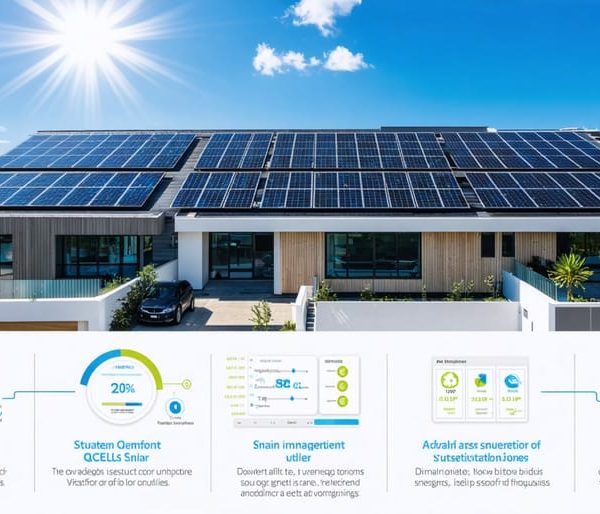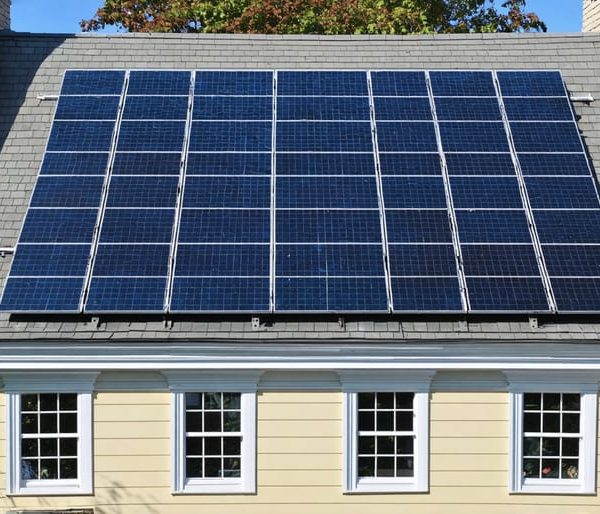Historic Buildings Go Green: Smart Solar Solutions That Preserve Character
Transform your building into a sustainable powerhouse while preserving its historic character through modern solar integration. The remarkable evolution of solar technology has made it possible to seamlessly blend renewable energy solutions with architectural preservation.
Today’s innovative solar installations offer property owners unprecedented flexibility – from nearly invisible solar tiles that mimic traditional roofing to sleek panels that complement historic facades. Leading architects and preservation specialists have successfully retrofitted countless landmark buildings with solar technology, reducing energy costs by 40-60% while maintaining original architectural integrity.
Whether you manage a Victorian-era home or a mid-century commercial building, contemporary solar solutions provide multiple integration options. Cutting-edge mounting systems can be installed without compromising structural elements, while advanced micro-inverter technology ensures optimal performance even on complex rooflines. The result: buildings that honor their past while embracing a sustainable future.
With federal tax incentives covering up to 30% of installation costs and property values increasing by an average of 4.1% with solar additions, the time has never been better to enhance your historic property with clean energy technology.
Preserving Heritage While Embracing Solar Innovation

Solar Technologies Compatible with Historic Structures
Preserving the character of historic buildings while embracing innovative solar solutions is now possible thanks to specialized technologies designed specifically for heritage structures. Solar slate tiles and thin-film panels blend seamlessly with traditional roofing materials, maintaining the building’s authentic appearance while generating clean energy. These solutions are particularly effective for properties with strict preservation requirements.
Recently developed solar glass can replace existing window panes, turning them into subtle power generators without altering the building’s facade. For properties with generous grounds, ground-mounted solar arrays offer an alternative that keeps historic rooflines untouched while still providing substantial energy benefits.
Solar thermal systems can be discretely integrated into existing water heating systems, often utilizing hidden storage tanks in basements or outbuildings. Additionally, removable solar panels mounted on free-standing frames provide temporary solutions that respect preservation guidelines while delivering renewable energy benefits.
These adaptable technologies demonstrate that historical preservation and sustainable energy can work hand in hand, ensuring our architectural heritage remains both preserved and environmentally responsible.
Meeting Preservation Guidelines
Integrating solar energy into historic buildings requires careful attention to preservation guidelines and local regulations. Property owners must work closely with preservation boards and local authorities to ensure solar installations respect the architectural integrity of protected structures. Many jurisdictions now offer specific guidelines for “sensitive solar integration,” which outline acceptable installation methods that minimize visual impact.
The key is finding the right balance between modern energy efficiency and historical authenticity. Some recommended approaches include installing panels on non-visible roof sections, using solar tiles that match historical materials, or placing arrays in ground-mounted locations away from the main structure. Documentation of the original building features and a detailed installation plan are typically required for approval.
Most preservation boards look favorably on reversible installations that don’t permanently alter historic materials. Working with solar installers who have experience with historic properties can help ensure compliance while maximizing energy benefits. Remember to obtain all necessary permits and approvals before beginning any installation work, as unauthorized modifications can result in penalties and required removal of equipment.
Smart Integration Solutions
Non-Invasive Installation Techniques
Installing solar panels on historic buildings requires a delicate balance between modern technology and preservation. Fortunately, several non-invasive techniques make this possible without compromising architectural integrity.
Ballasted mounting systems are among the most popular solutions, using weight-based anchoring instead of penetrating the building’s structure. These systems rely on heavy blocks or trays that keep solar panels securely in place through gravity, eliminating the need for roof penetrations.
Removable clip systems offer another excellent option, particularly for standing seam metal roofs. These specialized clamps attach to the raised seams without drilling or permanent modifications, making them ideal for historic metal roofing.
For buildings with flat roofs, solar canopy systems can be installed without touching the historic structure. These elevated frameworks distribute weight across the roof while providing additional benefits like shade and weather protection.
Innovative adhesive mounting solutions have also emerged, using industrial-strength materials that secure panels without penetrating the building envelope. These systems undergo rigorous testing to ensure they meet wind and weather resistance standards while remaining completely reversible.
Before installation, professionals conduct detailed structural assessments to determine the most appropriate non-invasive method. They also work closely with preservation specialists to ensure all modifications align with historic preservation guidelines and local regulations.
Through these careful approaches, building owners can embrace solar technology while maintaining their property’s historical significance for future generations.
Concealed Solar Technologies
Gone are the days when solar panels had to be conspicuously mounted on rooftops. Modern solar technology offers numerous elegant solutions that seamlessly blend with architectural designs while harnessing clean energy. One of the most revolutionary developments is solar tiles, which replicate the appearance of traditional roof shingles while generating power. These innovative tiles are particularly popular among homeowners who want to maintain their property’s classic look while embracing renewable energy.
Another groundbreaking option is transparent solar panels, which can be integrated into windows and skylights. These cutting-edge materials allow natural light to pass through while capturing solar energy, making them perfect for commercial buildings and modern homes. Property owners can now choose from various aesthetically-conscious solar panels that complement their building’s design rather than detract from it.
Solar skins represent another innovative concealment solution, allowing panels to display custom patterns or match roof coloring while maintaining high energy efficiency. For historic buildings, solar slates offer a particularly appealing option, as they’re designed to mimic traditional slate roofing while incorporating photovoltaic technology. These concealed solutions make it possible to embrace solar power without compromising architectural integrity, opening up new possibilities for sustainable building design.

Energy Storage Solutions
Energy storage is a crucial component of solar-powered historic buildings, allowing them to maintain their charm while embracing modern sustainability. Battery systems have evolved significantly, offering solutions that can be discreetly integrated into heritage properties without compromising their architectural integrity.
Modern lithium-ion battery banks can be installed in basements or utility rooms, keeping them out of sight while efficiently storing excess solar power for nighttime use or cloudy days. These systems are particularly effective when paired with hybrid solar systems, which intelligently manage power flow between solar panels, batteries, and the grid.
Smart energy management systems play a vital role in optimizing storage solutions. These systems monitor energy production and consumption patterns, automatically adjusting storage and usage to maximize efficiency. Many historic building owners have reported significant cost savings after installing these intelligent storage solutions, with some achieving up to 80% reduction in grid dependency.
For properties with limited interior space, outdoor battery enclosures can be designed to complement historical aesthetics. These weatherproof units can be disguised as period-appropriate structures or screened with traditional landscaping elements. The key is selecting storage solutions that balance modern functionality with historical preservation requirements, ensuring your building maintains its character while embracing clean energy technology.
Success Stories and Real-World Examples
Notable Renovations
Several historic buildings have successfully integrated solar technology while preserving their architectural heritage. The Reichstag building in Berlin stands as a prime example, where a sophisticated solar system provides 40% of the parliament building’s power needs through rooftop panels that complement its historic dome.
In the United States, the Bullitt Center in Seattle transformed a century-old structure into the world’s first certified Living Building, generating 60% more energy than it uses through strategic solar panel placement. The renovation team worked closely with preservation experts to ensure the panels didn’t compromise the building’s historic character.
The Valencia Opera House in Spain showcases how solar integration can enhance rather than detract from architectural beauty. Its roof features specially designed solar tiles that match the building’s original aesthetic while generating substantial clean energy.
Closer to home, the Historic Green Village on Anna Maria Island, Florida, demonstrates how multiple historic buildings can achieve net-zero energy status. The project maintains the village’s 1930s charm while incorporating modern solar technology, proving that preservation and sustainability can work hand in hand.
These successful renovations show that with careful planning and innovative design, solar installations can respect historical integrity while moving buildings into a sustainable future.

Performance Metrics
Solar energy buildings consistently demonstrate impressive performance metrics that validate their environmental and economic benefits. On average, buildings equipped with solar panels see a 50-70% reduction in their annual electricity costs, with some achieving complete energy independence during peak sunlight hours.
The environmental impact is equally remarkable. A typical commercial building with a 100kW solar installation prevents approximately 175 tons of carbon dioxide emissions annually – equivalent to planting 4,000 trees. These buildings also reduce water consumption related to traditional power generation by up to 95%.
Energy monitoring data shows that solar buildings maintain stable power output for 25-30 years, with panels losing only about 0.5% efficiency per year. Modern solar installations typically achieve a power density of 10-15 watts per square foot, making efficient use of limited roof space.
Return on investment (ROI) figures are particularly encouraging. Most building owners see complete cost recovery within 5-8 years, while enjoying increased property values of 3-4%. Additionally, solar buildings often earn higher energy performance certificates, leading to better insurance rates and improved marketability.
In terms of reliability, solar buildings with battery storage systems maintain power availability rates of 99.9%, even during grid outages. This resilience, combined with minimal maintenance requirements of just 1-2 annual inspections, makes solar integration an increasingly attractive option for property owners.
The integration of solar energy into buildings represents a pivotal step toward a more sustainable future while honoring our architectural heritage. As we’ve explored throughout this article, solar solutions offer compelling benefits that extend far beyond environmental impact. Property owners who embrace solar technology can expect significant reductions in energy costs, increased property values, and enhanced energy independence, all while contributing to a cleaner planet.
The success stories we’ve shared demonstrate that historical preservation and renewable energy adoption aren’t mutually exclusive. Through careful planning, innovative design solutions, and modern installation techniques, solar panels can seamlessly blend with traditional architecture. The key lies in finding the right balance between preserving historical character and embracing clean energy technology.
For those considering solar adoption, remember that every building’s journey toward sustainability is unique. Start by consulting with preservation experts and solar specialists who understand the delicate balance between historical integrity and modern energy solutions. Take advantage of available incentives, tax credits, and financing options that can make the transition more affordable.
The future of our built environment depends on our ability to adapt while respecting the past. Solar energy buildings represent more than just a trend – they’re a testament to human ingenuity and our commitment to responsible stewardship of both historical architecture and natural resources. As technology continues to advance, we can expect even more elegant solutions that bridge the gap between preservation and innovation.
By taking action today, you’re not just investing in your property’s future; you’re participating in a larger movement toward sustainable living. Whether you own a Victorian mansion or manage a historic commercial property, solar energy can be part of your building’s story while preserving its unique character for generations to come. The time to embrace solar energy is now – your building’s history and future will thank you.











